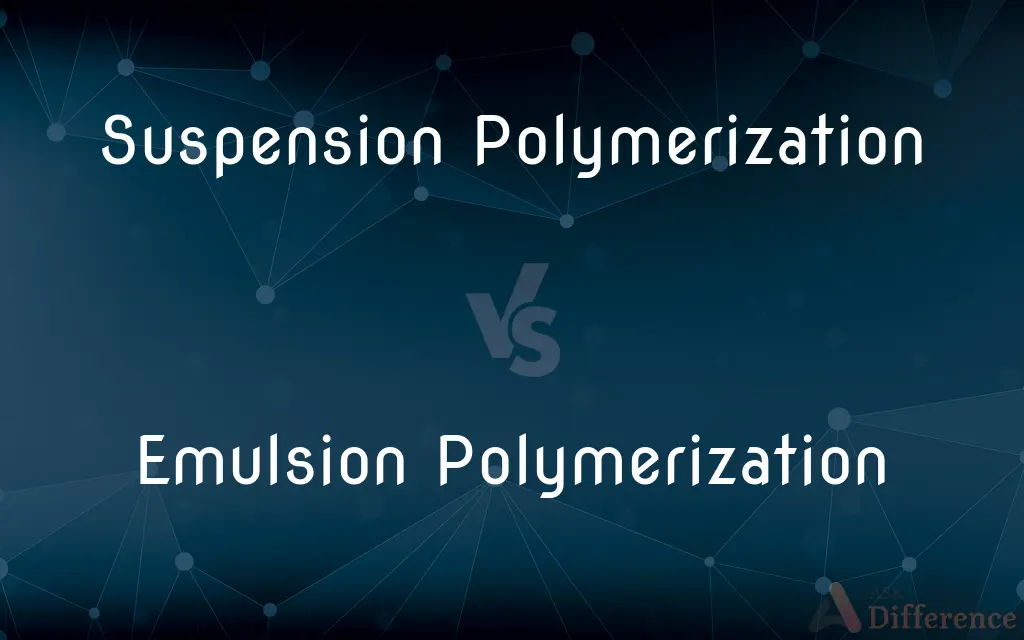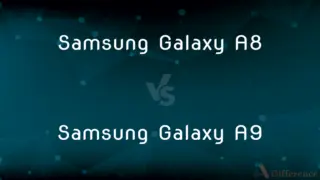Suspension Polymerization vs. Emulsion Polymerization — What's the Difference?
By Tayyaba Rehman — Published on December 28, 2023
Suspension Polymerization involves monomer droplets suspended in water, while Emulsion Polymerization has monomers emulsified with surfactants. Both are polymer production techniques.

Difference Between Suspension Polymerization and Emulsion Polymerization
Table of Contents
ADVERTISEMENT
Key Differences
Suspension Polymerization is a process where monomer droplets, which are to be polymerized, are suspended in an aqueous phase. These droplets act as tiny reactors where polymerization occurs. Emulsion Polymerization, conversely, involves the dispersion of monomers in water using surfactants, forming micelles that act as the sites of polymerization.
In Suspension Polymerization, the polymer forms within discrete droplets, which are essentially stabilized by a suspending agent to prevent them from coalescing. In Emulsion Polymerization, the micelles formed by the surfactant encapsulate the monomer, ensuring that the polymerization takes place within these micelles.
Suspension Polymerization results in beads or granules of the polymer, making it suitable for processes that require polymer in such forms. On the other hand, Emulsion Polymerization produces a latex, which is a colloidal dispersion of polymer particles in water.
A key distinction is the stabilizing agent used. In Suspension Polymerization, it's usually a water-soluble gum or gel, while in Emulsion Polymerization, it's a surfactant. The choice between these two methods often depends on the desired end product and its application.
It's noteworthy to mention that while both processes occur in aqueous environments, the mechanisms and end products differ significantly. The particles produced in Suspension Polymerization are larger, whereas Emulsion Polymerization results in finer particles.
ADVERTISEMENT
Comparison Chart
Mechanism
Monomer droplets suspended in water.
Monomers emulsified with surfactants.
Polymer Form
Beads or granules.
Latex or colloidal dispersion.
Stabilizing Agent
Water-soluble gum or gel.
Surfactant.
Particle Size
Larger particles.
Finer particles.
Suitable For
Processes requiring polymer beads/granules.
Processes requiring finely dispersed polymer in water.
Compare with Definitions
Suspension Polymerization
A method where monomers are suspended in water for polymerization.
Producing PVC through Suspension Polymerization results in granular resins.
Emulsion Polymerization
Technique yielding finely dispersed polymer particles in water.
Many household products contain polymers made via Emulsion Polymerization.
Suspension Polymerization
Polymerizing technique using monomer droplets in an aqueous phase.
Polystyrene beads are often manufactured using Suspension Polymerization.
Emulsion Polymerization
Method where micelles formed by surfactants act as polymerization sites.
Producing certain paints involves the Emulsion Polymerization process.
Suspension Polymerization
Polymerization where water-soluble agents stabilize monomer droplets.
In making certain plastics, Suspension Polymerization offers the desired bead-like form.
Emulsion Polymerization
Polymerizing technique creating a colloidal dispersion in water.
The production of certain adhesives uses the principles of Emulsion Polymerization.
Suspension Polymerization
Process using discrete droplets as mini reactors for polymerization.
The creation of PMMA beads involves the Suspension Polymerization method.
Emulsion Polymerization
Process using surfactants to emulsify monomers for polymerization.
Emulsion Polymerization is commonly used to produce rubber latex.
Suspension Polymerization
Technique yielding bead or granule form of polymers.
The polymer granules found in some commercial products are outcomes of Suspension Polymerization.
Emulsion Polymerization
Polymerization in which monomers are encapsulated within surfactant micelles.
The fine particles in some coatings result from Emulsion Polymerization.
Common Curiosities
What does Emulsion Polymerization yield?
Emulsion Polymerization produces a latex, which is a colloidal dispersion of polymer particles in water.
How does Emulsion Polymerization differ from Suspension Polymerization?
Emulsion Polymerization emulsifies monomers with surfactants, producing finer particles, while Suspension Polymerization results in larger bead-like polymers.
What are the end products of Suspension Polymerization?
It typically produces beads or granules of the polymer.
Why choose Emulsion Polymerization over Suspension Polymerization?
The choice depends on the desired end product; Emulsion Polymerization is ideal for products requiring finely dispersed polymer in water.
What is Suspension Polymerization?
Suspension Polymerization is a method where monomers are suspended in water to undergo polymerization.
Are surfactants used in Suspension Polymerization?
No, surfactants are primarily used in Emulsion Polymerization. In Suspension Polymerization, water-soluble gums or gels are used.
What stabilizes the monomer droplets in Suspension Polymerization?
Water-soluble gums or gels typically stabilize the droplets.
Are both methods carried out in aqueous environments?
Yes, both Suspension and Emulsion Polymerization occur in aqueous environments.
What's the primary role of surfactants in Emulsion Polymerization?
In Emulsion Polymerization, surfactants help in forming micelles that encapsulate and emulsify the monomer.
Can any monomer be used in Suspension Polymerization?
Not all monomers are suitable; the choice depends on the monomer's reactivity and the desired polymer properties.
Which polymerization method is more suitable for producing paints?
Emulsion Polymerization is commonly used for producing paints due to its ability to create fine polymer dispersions.
Is the particle size in Emulsion Polymerization larger than in Suspension Polymerization?
No, Emulsion Polymerization generally produces finer particles compared to Suspension Polymerization.
Which method is used to produce PVC?
PVC is commonly produced using Suspension Polymerization.
How are monomers dispersed in Emulsion Polymerization?
Monomers are emulsified using surfactants, forming micelles that act as polymerization sites.
Are the mechanisms of Suspension and Emulsion Polymerization similar?
Though both occur in aqueous environments, their mechanisms differ significantly, mainly in how monomers are dispersed and where polymerization occurs.
Share Your Discovery

Previous Comparison
Samsung Galaxy A8 vs. Samsung Galaxy A9
Next Comparison
Apical Meristems vs. Lateral MeristemsAuthor Spotlight
Written by
Tayyaba RehmanTayyaba Rehman is a distinguished writer, currently serving as a primary contributor to askdifference.com. As a researcher in semantics and etymology, Tayyaba's passion for the complexity of languages and their distinctions has found a perfect home on the platform. Tayyaba delves into the intricacies of language, distinguishing between commonly confused words and phrases, thereby providing clarity for readers worldwide.













































